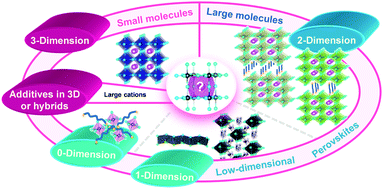当前位置:
X-MOL 学术
›
Energy Environ. Sci.
›
论文详情
Our official English website, www.x-mol.net, welcomes your
feedback! (Note: you will need to create a separate account there.)
Molecular aspects of organic cations affecting the humidity stability of perovskites
Energy & Environmental Science ( IF 32.4 ) Pub Date : 2020/02/10 , DOI: 10.1039/c9ee03473k Bohyung Kim 1, 2, 3, 4, 5 , Sang Il Seok 1, 2, 3, 4, 5
Energy & Environmental Science ( IF 32.4 ) Pub Date : 2020/02/10 , DOI: 10.1039/c9ee03473k Bohyung Kim 1, 2, 3, 4, 5 , Sang Il Seok 1, 2, 3, 4, 5
Affiliation

|
Two important factors in solar cells are efficiency and long-term stability. The commercialization of halide perovskite solar cells (PSCs) containing organic cations may be limited due to their low stability, in spite of their high efficiency. The molecular features of the organic cations adopted in perovksites belong to a subset of ammonium cations, such as methylammonium (MA), which are known to display poor humidity stability. Based on the molecular aspects of organic cations, the humidity stability of perovskites can be affected by their structural stability, the hydrophobicity, chemical environment near the heteroatom, and stereochemistry. Organic cations with large ionic radii produce two-dimensional (2D) structures with significantly improved stability. 2D perovskites show high humidity stability due to their increased chemical stability and hydrophobicity, but have the drawback of slow charge transport due to the insulating properties of the organic cations. Accordingly, many efforts have been devoted to form conductive inorganic layers in 2D perovskites in addition to the light-active layer of PSCs in several ways. In this perspective, we have analyzed the possible degradation initiators formed under humid conditions based on a comprehensive review of the literature, followed by practical experimental results using ammonium-driven PSCs, focusing on their humidity stability and device performance. As a strategy to enhance the wet-fastness of perovskites, we propose new under-explored sulfonium cations (R3S+), showing characteristic stereochemistry and significantly increased humidity stability of perovskites, which differ from conventional protic ammonium cations.
中文翻译:

影响阳离子钙钛矿湿度稳定性的有机阳离子的分子方面
太阳能电池中的两个重要因素是效率和长期稳定性。尽管有机阳离子的卤化钙钛矿太阳能电池(PSC)效率很高,但它们的稳定性很低,因此可能会受到限制。钙钛矿中采用的有机阳离子的分子特征属于铵阳离子的子集,例如甲基铵(MA),已知其表现出较差的湿度稳定性。基于有机阳离子的分子方面,钙钛矿的湿度稳定性会受到其结构稳定性,疏水性,杂原子附近的化学环境和立体化学的影响。具有大离子半径的有机阳离子可产生具有显着改善的稳定性的二维(2D)结构。2D钙钛矿由于其增加的化学稳定性和疏水性而显示出高的湿度稳定性,但由于有机阳离子的绝缘性而具有电荷传输缓慢的缺点。因此,除了以几种方式的PSC的光活性层以外,还已经进行了许多努力来形成二维钙钛矿中的导电无机层。从这个角度出发,我们在全面回顾文献的基础上,分析了在潮湿条件下可能形成的降解引发剂,随后给出了使用铵驱动的PSC的实际实验结果,重点是其湿度稳定性和器件性能。作为提高钙钛矿湿牢度的策略,我们提出了新的未充分开发的sulf阳离子(R 但是由于有机阳离子的绝缘性能而具有电荷传输缓慢的缺点。因此,除了以几种方式的PSC的光活性层以外,还已经进行了许多努力来形成二维钙钛矿中的导电无机层。从这个角度出发,我们在全面回顾文献的基础上,分析了在潮湿条件下可能形成的降解引发剂,随后给出了使用铵驱动的PSC的实际实验结果,重点是其湿度稳定性和器件性能。作为提高钙钛矿湿牢度的策略,我们提出了新的未充分开发的sulf阳离子(R 但是由于有机阳离子的绝缘性能而具有电荷传输缓慢的缺点。因此,除了以几种方式的PSC的光活性层以外,还已经进行了许多努力来形成二维钙钛矿中的导电无机层。从这个角度出发,我们在全面回顾文献的基础上,分析了在潮湿条件下可能形成的降解引发剂,随后给出了使用铵驱动的PSC的实际实验结果,重点是其湿度稳定性和器件性能。作为提高钙钛矿湿牢度的策略,我们提出了新的未充分开发的sulf阳离子(R 从这个角度出发,我们在全面回顾文献的基础上,分析了在潮湿条件下可能形成的降解引发剂,随后给出了使用铵驱动的PSC的实际实验结果,重点是其湿度稳定性和器件性能。作为提高钙钛矿湿牢度的策略,我们提出了新的未充分开发的sulf阳离子(R 从这个角度出发,我们在全面回顾文献的基础上,分析了在潮湿条件下可能形成的降解引发剂,随后给出了使用铵驱动的PSC的实际实验结果,重点是其湿度稳定性和器件性能。作为提高钙钛矿湿牢度的策略,我们提出了新的未充分开发的sulf阳离子(R3 S +),表现出独特的立体化学和钙钛矿的湿度稳定性,与传统的质子铵阳离子不同。
更新日期:2020-03-19
中文翻译:

影响阳离子钙钛矿湿度稳定性的有机阳离子的分子方面
太阳能电池中的两个重要因素是效率和长期稳定性。尽管有机阳离子的卤化钙钛矿太阳能电池(PSC)效率很高,但它们的稳定性很低,因此可能会受到限制。钙钛矿中采用的有机阳离子的分子特征属于铵阳离子的子集,例如甲基铵(MA),已知其表现出较差的湿度稳定性。基于有机阳离子的分子方面,钙钛矿的湿度稳定性会受到其结构稳定性,疏水性,杂原子附近的化学环境和立体化学的影响。具有大离子半径的有机阳离子可产生具有显着改善的稳定性的二维(2D)结构。2D钙钛矿由于其增加的化学稳定性和疏水性而显示出高的湿度稳定性,但由于有机阳离子的绝缘性而具有电荷传输缓慢的缺点。因此,除了以几种方式的PSC的光活性层以外,还已经进行了许多努力来形成二维钙钛矿中的导电无机层。从这个角度出发,我们在全面回顾文献的基础上,分析了在潮湿条件下可能形成的降解引发剂,随后给出了使用铵驱动的PSC的实际实验结果,重点是其湿度稳定性和器件性能。作为提高钙钛矿湿牢度的策略,我们提出了新的未充分开发的sulf阳离子(R 但是由于有机阳离子的绝缘性能而具有电荷传输缓慢的缺点。因此,除了以几种方式的PSC的光活性层以外,还已经进行了许多努力来形成二维钙钛矿中的导电无机层。从这个角度出发,我们在全面回顾文献的基础上,分析了在潮湿条件下可能形成的降解引发剂,随后给出了使用铵驱动的PSC的实际实验结果,重点是其湿度稳定性和器件性能。作为提高钙钛矿湿牢度的策略,我们提出了新的未充分开发的sulf阳离子(R 但是由于有机阳离子的绝缘性能而具有电荷传输缓慢的缺点。因此,除了以几种方式的PSC的光活性层以外,还已经进行了许多努力来形成二维钙钛矿中的导电无机层。从这个角度出发,我们在全面回顾文献的基础上,分析了在潮湿条件下可能形成的降解引发剂,随后给出了使用铵驱动的PSC的实际实验结果,重点是其湿度稳定性和器件性能。作为提高钙钛矿湿牢度的策略,我们提出了新的未充分开发的sulf阳离子(R 从这个角度出发,我们在全面回顾文献的基础上,分析了在潮湿条件下可能形成的降解引发剂,随后给出了使用铵驱动的PSC的实际实验结果,重点是其湿度稳定性和器件性能。作为提高钙钛矿湿牢度的策略,我们提出了新的未充分开发的sulf阳离子(R 从这个角度出发,我们在全面回顾文献的基础上,分析了在潮湿条件下可能形成的降解引发剂,随后给出了使用铵驱动的PSC的实际实验结果,重点是其湿度稳定性和器件性能。作为提高钙钛矿湿牢度的策略,我们提出了新的未充分开发的sulf阳离子(R3 S +),表现出独特的立体化学和钙钛矿的湿度稳定性,与传统的质子铵阳离子不同。











































 京公网安备 11010802027423号
京公网安备 11010802027423号